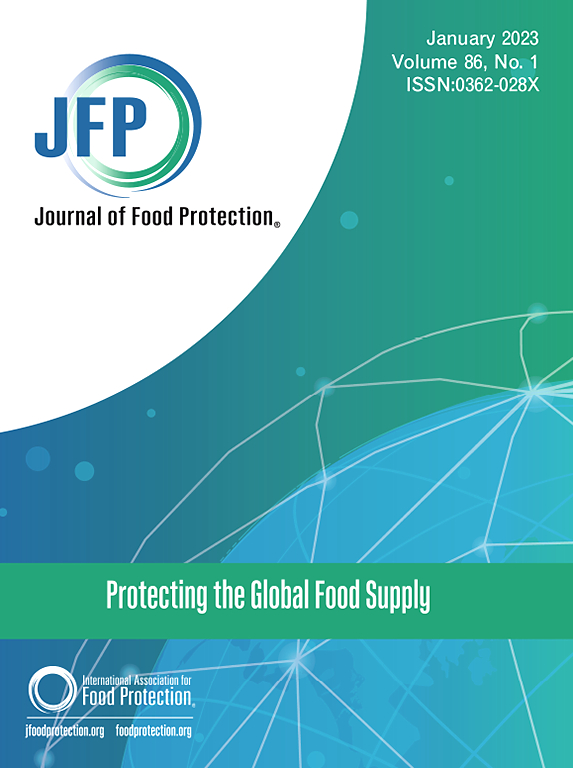水-土壤-植物-食物关系中隐孢子虫的优化分子检测:推进农业系统监测。
IF 2.8
4区 农林科学
Q3 BIOTECHNOLOGY & APPLIED MICROBIOLOGY
引用次数: 0
摘要
隐孢子虫是一种引起人类和动物严重腹泻疾病的原生动物寄生虫,由于寄生虫浓度低、抑制剂和DNA提取效率低,给检测带来了挑战。本研究优化了环境样品中隐孢子虫DNA的提取和检测方法,并对其在农业中的实际应用进行了评价。通过对11种加标磷酸盐缓冲盐水(PBS)样品的DNA提取方法进行评价,选择了3种用于水、土壤和新鲜农产品中隐孢子虫分子检测的方法,并采用实时荧光定量PCR技术对其进行检测。共制备了188份人工污染样品,包括蒸馏水(n=36)、环境水(n=44)、土壤(n=36)和新鲜农产品(生菜和菠菜;n = 72)。每个样品连续接种12500 ~ 5个隐孢子虫卵囊,采用实时荧光定量PCR和液滴数字PCR (ddPCR)检测灵敏度。结果表明,不同基质的提取效果不同,两种旋转柱试剂盒对水的提取效果较好,另一种试剂盒对土壤和农产品的提取效果较好。偶尔可以检测到来自5个卵囊的DNA,与实时PCR相比,ddPCR更不容易受到PCR抑制剂的影响。然后应用这些方法检测了来自南非小规模农场的210个环境样本(水、土壤、农产品)中的隐孢子虫。real-time PCR无阳性,而ddPCR在13.6%的水、23.3%的土壤和34.7%的新鲜农产品样品中检出隐孢子虫。地表水污染最高,达28.6%。同时施用肥料和粪肥的土壤污染率为45%。在蔬菜中,根受影响最大(46.7%),其次是水果(40%)和绿叶蔬菜(30.15%)。这些发现强调了隐孢子虫在食品系统中的健康风险,以及改进检测方法以加强监测和为未来的疫情预防战略提供信息的必要性。本文章由计算机程序翻译,如有差异,请以英文原文为准。
Optimized Molecular Detection of Cryptosporidium Within the Water-Soil-Plant-Food Nexus: Advancing Surveillance in Agricultural Systems
Cryptosporidium, a protozoan parasite causing severe diarrheal illness in humans and animals, poses detection challenges due to low parasite concentrations, inhibitors, and inefficient DNA extraction. This study optimized DNA extraction and detection of Cryptosporidium in environmental samples and evaluated their practical use in agriculture. After evaluating 11 DNA extraction methods from spiked phosphate-buffered saline (PBS) samples, three methods for molecular detection of Cryptosporidium in water, soil, and fresh produce were selected and further tested using real-time PCR. A total of 188 artificially contaminated samples were prepared, consisting of distilled water (n = 36), environmental water (n = 44), soil (n = 36), and fresh produce (lettuce and spinach; n = 72). Each sample was inoculated with serial dilutions of 12,500 to 5 Cryptosporidium oocysts and tested using real-time PCR and droplet digital PCR (ddPCR) to evaluate detection sensitivity. Results demonstrated that extraction performance varied by matrix, with two spin-column kits excelling for water and another for soil and produce. DNA from as few as five oocysts was occasionally detectable, with ddPCR being less prone to be affected by PCR inhibitors than real-time PCR. These methods were then applied to detect Cryptosporidium in 210 environmental samples (water, soil, produce) from South African small-scale farms. None of the samples tested positive with real-time PCR, while ddPCR detected Cryptosporidium in 13.6% of water, 23.3% of soil, and 34.7% of fresh produce samples. Surface water showed the highest contamination at 28.6%. Soil amended with both fertilizer and manure had a 45% contamination rate. Among vegetables, roots were most affected (46.7%), followed by fruiting (40%) and leafy greens (30.15%). These findings highlight the health risks of Cryptosporidium in food systems and the need for improved detection methods to enhance surveillance and inform future outbreak prevention strategies.
求助全文
通过发布文献求助,成功后即可免费获取论文全文。
去求助
来源期刊

Journal of food protection
工程技术-生物工程与应用微生物
CiteScore
4.20
自引率
5.00%
发文量
296
审稿时长
2.5 months
期刊介绍:
The Journal of Food Protection® (JFP) is an international, monthly scientific journal in the English language published by the International Association for Food Protection (IAFP). JFP publishes research and review articles on all aspects of food protection and safety. Major emphases of JFP are placed on studies dealing with:
Tracking, detecting (including traditional, molecular, and real-time), inactivating, and controlling food-related hazards, including microorganisms (including antibiotic resistance), microbial (mycotoxins, seafood toxins) and non-microbial toxins (heavy metals, pesticides, veterinary drug residues, migrants from food packaging, and processing contaminants), allergens and pests (insects, rodents) in human food, pet food and animal feed throughout the food chain;
Microbiological food quality and traditional/novel methods to assay microbiological food quality;
Prevention of food-related hazards and food spoilage through food preservatives and thermal/non-thermal processes, including process validation;
Food fermentations and food-related probiotics;
Safe food handling practices during pre-harvest, harvest, post-harvest, distribution and consumption, including food safety education for retailers, foodservice, and consumers;
Risk assessments for food-related hazards;
Economic impact of food-related hazards, foodborne illness, food loss, food spoilage, and adulterated foods;
Food fraud, food authentication, food defense, and foodborne disease outbreak investigations.
 求助内容:
求助内容: 应助结果提醒方式:
应助结果提醒方式:


